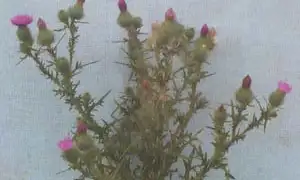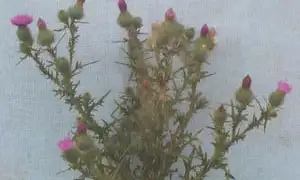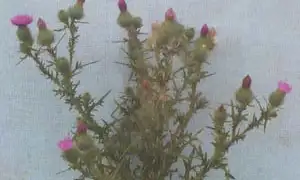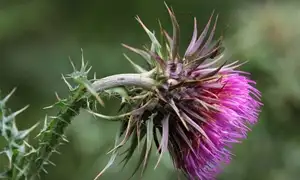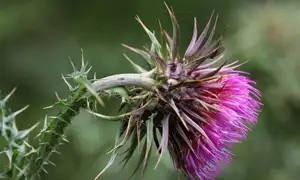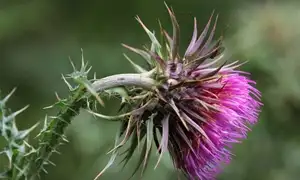Botanical name: Carduus tenuiflorus
Family name: Asteraceae
Overview
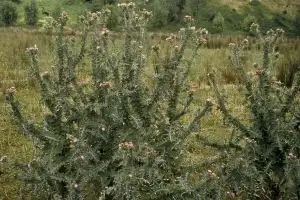
Winged thistle.
Winged thistle is a winter annual, which means it generally establishes from seed in autumn, grows as a typical thistle rosette over winter, then develops an upright flower stem in spring, from which seed is produced and falls into the soil where it spends summer.
The plants are usually dead through late summer, unlike biennial weeds like Scotch thistle and nodding thistle, or the perennial species, Californian thistle, which all have some plants present through summer. Because of this, winged thistles are well suited to pastures that are prone to drying out in summer and need pasture density to be sparse during autumn from summer dryness so that the seedlings can establish.
Winged thistle looks and behaves very similarly to slender winged thistle (Carduus pycnocephalus), so the two species are commonly confused with each other. Slender winged thistle is more tolerant of dry conditions than winged thistle, and is often the more common of the two species in eastern parts of New Zealand such as Hawkes Bay. Winged thistle is found throughout New Zealand, though evidently not in Westland.
Distinguishing features
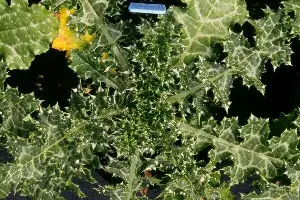
Winged thistle rosette.
In the vegetative stage, the winged thistle has the typical prickly rosette of a thistle species, though it tends to have some faint whitish venation in leaves, but not as strongly as in variegated thistle (Silybum marianum).
In the flowering stage, the flower heads of winged thistle are smaller than those in nodding thistle (Carduus nutans), Scotch thistle (Cirsium vulgare) or variegated thistle, but similar in size to Californian thistle (Cirsium arvense) and marsh thistle (Cirsium palustre).
Each flower head is up to 2 cm long and about 1.5 cm wide, and there are usually clusters of these heads at the ends of each stem, with about 3-8 heads per stem. Slender winged thistle has less, with about 1-3 heads per stem.
The winged thistle has spiny strips of leaf material up its stems, and these are known as wings, hence the name winged thistle. Californian thistle, the other common small flowered thistle species, has much less wing material up its stems. Slender winged thistle also has much less noticeable wings up the stems, especially near the top.
Under dry conditions though, a winged thistle can become more slender too like the slender winged thistle. One feature I have found works quite well for telling winged thistle from slender winged thistle is the length of the pappus material around the seeds as they blow out of the seed heads. The pappus filaments for winged thistle tend to be about 11 mm long, whereas in slender winged thistle they tend to be about 16 mm long.
Control

Winged thistle stem and flowers.
If possible, try to have pastures dense in autumn to stop seedlings establishing, perhaps through the use of drought-tolerant pasture species, and not overgrazing through summer by using supplementary feed. If densities are low, the winged thistle can be removed using a chipping hoe, cutting about 1-2 cm below the crown of the thistle to ensure no buds are left attached to the root.
Herbicides are best applied while the thistle is still a young rosette as it tends to be less susceptible as it becomes reproductive. MCPB can be used on young rosettes, or else 2,4-D or MCPA on older plants.
In parts of Hawkes Bay, we have found populations of slender winged thistle that have developed resistance to MCPB, MCPA and 2,4-D, but we don’t think this has happened in winged thistle.
In flat paddocks, the use of a weed wiper may be an option after stem elongation has occurred in spring but before seeds have formed, using a translocated herbicide like glyphosate to move into the forming seeds and prevent healthy seeds from being put back into the soil.
Spot-spraying is another option for flowering plants, using herbicides such as aminopyralid (T-Max), 2,4-D/dicamba, clopyralid or triclopyr/picloram.
Similar species
Californian thistle
Californian thistle is a common perennial thistle with an underground creeping root system.
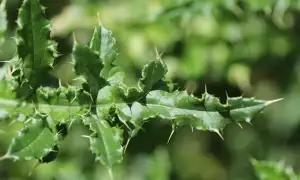
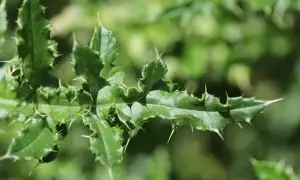
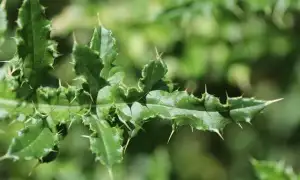

Scotch thistle
Scotch thistle is the most common thistle species in New Zealand with spines on both the leaf surface and margins.

